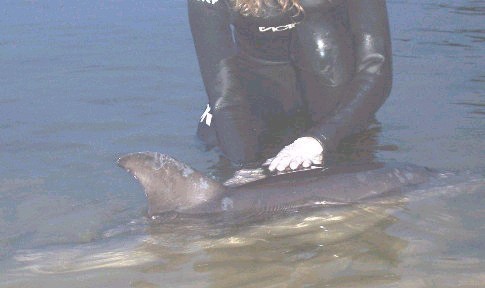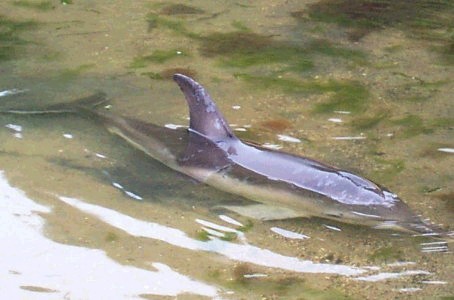|
Three common dolphins rescued from South beach Studland - UK
27th May 2003
Southern Marine Life Rescue
5.15pm Durlston Marine Project received call from member of the public reporting 3 dolphins stranded at South beach. Staff from the National Trust at Studland called DMP advising of situation. NT staff on scene were keeping members of public away and monitoring animals.
5.45pm DMP arrived on scene. Confirmed 3 dolphins in shallow water to south end of beach. 1 (smallest) appeared very sessile. Other 2 had periods of stillness interspersed by periods of thrashing in rocky, shallow water. Observed dolphins behaviour and kept public away. Gathered background from observers: dolphins had been present in bay since ~2.30pm. Seen coming close inshore and swimming slowly around bay before coming close in and remaining in shallow water. A number of children reported venturing out to pet and kiss (!) the dolphins. None of the animals had shown any resistance to the approaches of members of the public. Some reported trying to push the dolphins out to deeper water but the animals resisted and came back inshore.
6.15pm Southern Marine Life Rescue arrived. DMP & SMLR waded out to assess dolphins' condition. All appeared tired. None attempted to swim away from medics.
All had recent cuts and abrasions sustained from stranding. 2 smallest animals were quivering/shivering. Breathing rate ~every 20 seconds. One (dolphin B) (est. ~4ft) had very pronounced fungal infection around left eye area and apparent fungal infections on flanks. Smallest (dolphin A) (est. <3ft) had several small (est. 2cm d.), round abrasions or lesions on both flanks. Largest (dolphin C) of the 3 (est. 5ft) had no obvious external problems and was the liveliest. All three were very vocal.
6.30pm Vet was telephoned and advised of situation. Instructed rescuers to keep dolphins moving to prevent chilling. Local vet informed and mobilised.
7.15pm Call from vet to advise of delay (another call-out). Expected arrival time 8.15pm. Animals kept moving. Breathing rates increased to ~every 15 seconds. Animals tiring. Eyes closing. Moved animals closer to shore to allow for easier access by vet. Kept moist and moved animals around in between periods of resting. Animals appeared increasingly lethargic.
8.45pm Vet arrived (Paul Macfarlane) and assessed animals. Decision was made to administer antibiotics to all three of the animals. All showed powerful responses to the injection. The animals were moved around to improve circulation and uptake of injection.
Slowly, the smallest and
largest of the dolphins
improved. The largest
dolphin was assisted into
deeper water and began to
swim freely - its strength
appeared to improve.
The animal was kept
under observation and did
not return to shallower
waters but kept close to
the other two. The calf
was sexed and was female.
The dolphin whose
condition appeared the
worst was also female.
As rescuers approached the largest dolphin to determine the sex, it continued to swim further away. It was swimming much stronger than earlier and continued to swim offshore. The light was beginning to fade and observation of the dolphin was difficult. It was last spotted diving and swimming strongly out of the bay at around 9.30pm.
The calf began to show good response to the antibiotics and started to swim freely in deeper water. Rescuers discouraged the calf from swimming too close to the rocky shore. The animal was very vocal and did not stray far from the dolphin still inshore.
Dolphin B took the longest to exhibit any signs of recovery but eventually showed improved strength. The vet had decided to administer fluids and these were being prepared as the dolphin began to swim away from the shore. The rescuers tried to coax the animal back towards to shore but attempts were unsuccessful. The animal was vocalising and joined up with the calf who had been keeping a distance offshore. The two swam out to sea, following a similar path to dolphin C. The dolphins were last observed swimming strongly out to sea at about 9.50pm.
Rescuers are on standby should any of the animals re-strand.
Jo Wharam
Project Officer
Durlston Marine Project
http://www.durlston.co.uk
Top
|

